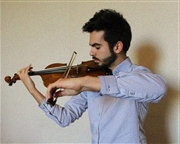Tutor HuntResources Violin Resources
Considerations On Violin Repertoire
Analysis of works by Dvorak and Beethoven
Date : 22/03/2017
Author Information

Uploaded by : Marcello
Uploaded on : 22/03/2017
Subject : Violin
Dvorak Sonata in F
Dvorak composed this Sonata during two weeks in March 1880, shortly after finalising the first version of the Violin Concerto op. 53. He previously composed the Violin Sonata in A minor (lost) and the Romance in F minor. Before the publishing of the score, the Sonata in F was played through with J zsef Joachim, with whom Dvorak already collaborated for the Violin Concerto.From the very first bars of this work it is evident a strong influence from Brahms`s style, especially in the rythmical treatment of themes in the first movement, and in the shape of melodies in the slow movement. The Allegro ma non troppo introduces an idillyc theme, contrasted by a playful second theme, folk-music inspired. The Poco sostenuto presents the dialogue between the two instruments on two themes, the first one showing a falling propensity in pitch and the second one describing rising phrases in a question/answer shape. The Allegro molto is a Rondo dominated by a Slavonic dance tune, interrupted by two melodic and humorous themes.Beethoven Violin Sonata n. 8 (op. 30 no. 3)
Beethoven Sonata no. 8 was composed in 1802, third of the op. 30 set, soon after the "Moonlight" Piano Sonata and Symphony no. 2, and a few months before the writing of the tragic letter to his brothers, known as the "Heiligenstadt Testament . However, no despair is expressed in this Sonata, with its vivacious outer movements and charming slow movement, only darkened by a short E-flat minor episode.The Allegro Assai opens with a cheerful and daring theme, which features will come back during the whole movement, sided by a passionate secondary theme in D minor. The central movement flows through long and colourful melodies, in which the composer explores the contrasting timbres and expressive qualities of both instruments. The Allegro vivace outbursts with a rustic dance, in a peasant festival mood, followed by its developed variants and a last unexpected and hilarious episode in the unrelated key of E-flat Major.
Dvorak composed this Sonata during two weeks in March 1880, shortly after finalising the first version of the Violin Concerto op. 53. He previously composed the Violin Sonata in A minor (lost) and the Romance in F minor. Before the publishing of the score, the Sonata in F was played through with J zsef Joachim, with whom Dvorak already collaborated for the Violin Concerto.From the very first bars of this work it is evident a strong influence from Brahms`s style, especially in the rythmical treatment of themes in the first movement, and in the shape of melodies in the slow movement. The Allegro ma non troppo introduces an idillyc theme, contrasted by a playful second theme, folk-music inspired. The Poco sostenuto presents the dialogue between the two instruments on two themes, the first one showing a falling propensity in pitch and the second one describing rising phrases in a question/answer shape. The Allegro molto is a Rondo dominated by a Slavonic dance tune, interrupted by two melodic and humorous themes.Beethoven Violin Sonata n. 8 (op. 30 no. 3)
Beethoven Sonata no. 8 was composed in 1802, third of the op. 30 set, soon after the "Moonlight" Piano Sonata and Symphony no. 2, and a few months before the writing of the tragic letter to his brothers, known as the "Heiligenstadt Testament . However, no despair is expressed in this Sonata, with its vivacious outer movements and charming slow movement, only darkened by a short E-flat minor episode.The Allegro Assai opens with a cheerful and daring theme, which features will come back during the whole movement, sided by a passionate secondary theme in D minor. The central movement flows through long and colourful melodies, in which the composer explores the contrasting timbres and expressive qualities of both instruments. The Allegro vivace outbursts with a rustic dance, in a peasant festival mood, followed by its developed variants and a last unexpected and hilarious episode in the unrelated key of E-flat Major.
This resource was uploaded by: Marcello
